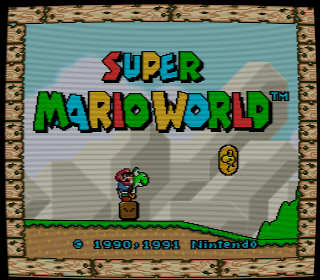It's been a while since I've done one of these posts and, in that time, RetroArch's multipass shader implementation has matured quite a bit, paving the way for a lot of really cool effects that simply can't be done in a single pass. At the time of this writing, higan's multipass shader implementation hasn't been released yet, but many of these shaders should be portable to it (with some substantial effort, at least) when it arrives.
As always, images were captured at 4x scale. Click the thumbnails to embiggen.
First up:
Themaister's NTSC Shader
Themaister wrote a sweet new real-time NTSC Composite shader that mimics a lot of the noise, fringing and crosstalk present in the NTSC composite signal:
This shader is a big deal because blargg's CPU-based NTSC filter was previously the only way to get this effect, which was important in some older games' art design. However, the filter had to be hardcoded to the individual consoles' specific resolution, which made it a headache to maintain in a multi-console setting. This shader should work on all of RetroArch's cores, and it is available in GLSL and Cg/cgp flavors.
I mixed it with cgwg's CRT shader and ended up with this (ntsc2-crt.shader):
You can compare that with an earlier version I cobbled together from the old NTSC shader--which tended to be finicky and not everyone liked anyway--and cgwg's CRT (crt-geom-interlaced-flat-ntsc.shader):
Digging through an old thread on byuu's forum, I also found where cgwg had written a similar shader that combined NTSC with CRT in 6 passes with barrel distortion (6-pass-ntsc+crt2.shader):
In the same thread, cgwg had posted this shader, called 'beam-dynamic,' that is essentially the same result as the beam4 shader mentioned in one of my other posts:
Out of all of these variations, I think my favorite is Themaister's NTSC with the addition of scanlines that have been softened with gaussian blur (ntsc2-maister-scanlines.shader):
Harlequin's Gameboy Shader
This shader does for Gameboy emulators what cgwg's CRT does for regular consoles, i.e., recreates the look of the original display with startling verisimilitude:
I'm not going to spend a lot of time talking about this shader here, even though it's completely badassed, since it's covered at length in a previous post. It's available in Cg/cgp format only, though you can use Themaister's handy cg-to-glsl python script to convert it to GLSL if necessary.
Harlequin's LCD Shader
Using some of the same concepts from the Gameboy shader, Harlequin is also working on a more generalized shader that mimics the low-resolution, slow-refreshing color LCD displays from a number of handheld consoles, such as Sega's Game Gear and Nintendo's Gameboy Advance:
Similarly, cgwg posted an LCD shader he's been working on that produces a regular, square pixel grid pattern, paired with some simple motion blur (lcd-cgwg.shader):
Motion Blur
Speaking of motion blur, I wrote a multipass version of this shader a while back and cgwg revised it down to a single pass (refers to previous frames, so still incompatible with higan v092 and earlier). This effect can be good for mimicking the slow response time of crummy LCDs (motion blur.shader):
I also made a version that only adds the blur during rewind, along with a little sepia-tone effect, kinda like the rewind effect in Braid (braid rewind.shader):
This shader can be added before pretty much any other shader (either manually by pasting in the code or by using the new, built-in RGUI shader stacking function and/or glslp shader configuration files) at a scale of 1.0 and the effect will only kick in when the game is rewinding :D
GTU
This shader from aliaspider is an interesting take on the CRT paradigm insofar as he didn't want to focus on phosphor emulation or heavy-handed scanlines or any of that other jazz. He was more interested in the blurring/blending effect of CRTs that enabled tricks like pseudo-hires transparency and color dithering. Later revisions include some sweet gamma correction and the ability to create mild scanlines (if you choose; GTUv031-multipass.shader):
I think this is one of the best ways to get pseudo-hires transparency working properly, and the transparency it creates is smooth and absolutely beautiful:
Aliaspider made a single-pass version of the shader that should work in higan v092 and earlier, along with the multipass version linked above for RetroArch, and a multipass version for higan v093's upcoming shader implementation.
My 4k Phosphor Shader
This is another one that I won't spend much time on, since I cover it at length in another post:
This shader currently doesn't look so hot as it's designed to work at around 10x scale (i.e., on a 4k resolution television or other high-DPI display; it gets wrecked by subpixel behavior at current normal scales [read: 1080p]). However, it brings some nice things to the table, such as easily-edited LUTs that can be created/modified in Photoshop/GIMP rather than a text editor and scale-ability to freaky-huge resolutions. I'll attempt to convert this to byuu's higan v093 format at some point, though it may take some time.

















